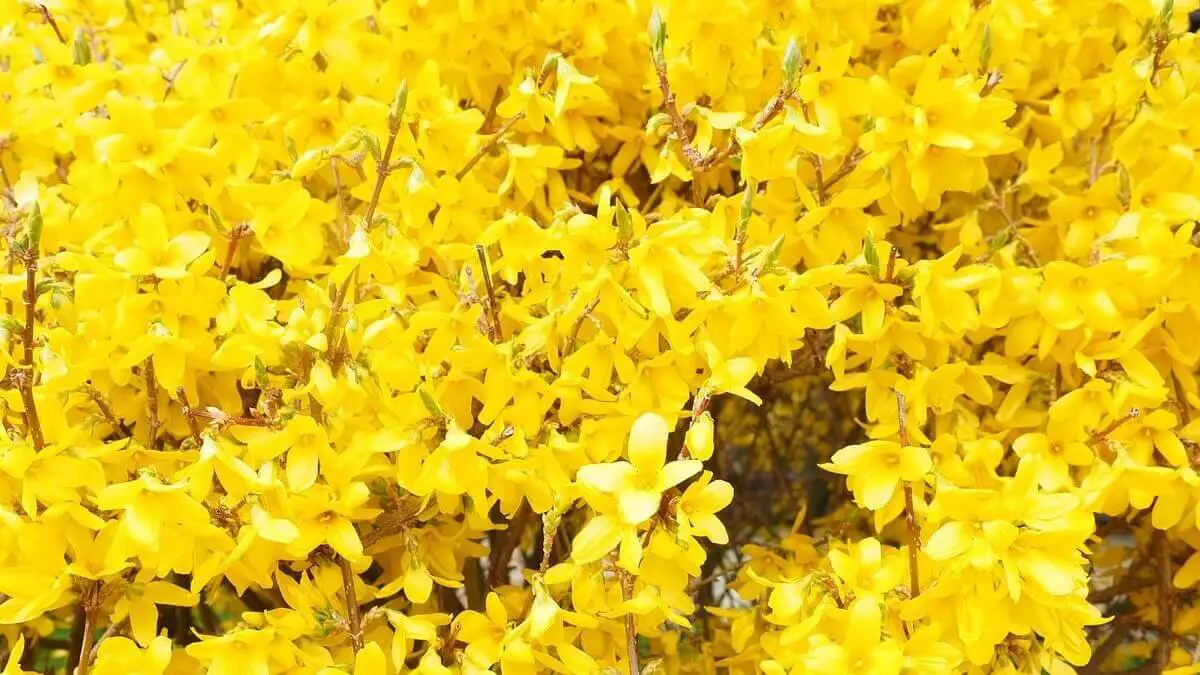All about Forsythia Hedge
Forsythia Hedge is a deciduous shrub. It is also known as the Easter tree. Biologically, its genus comes under the Oleaceae (olive) family. This genus is named after a Scottish botanist, William Forsyth (1737 – 1804). There are many species of Forsythia Hedge. Generally, most of them have native roots in eastern Asia. Only one of them (Forsythia Europaea) is native to southeastern Europe.
This article focuses on Forsythia Hedge, description, propagation, caring, and uses.
Forsythia Hedge is a cold hardy, salt, and drought-tolerant shrub. It is also a fast grower. You can use it to fence boundaries of your premises, block an unpleasant view, as a decorative wall in private garden rooms, shielding outer space from disturbing onlookers, and so on.
In spite of being a non-native US plant, it has naturalized in many parts of the US, particularly in zones 5 – 8. These plants grow quickly and require very little maintenance. Hence, you can grow them in your gardens with minimal care. However, you may have to prune them regularly for controlling their growth characteristics.
Table of Contents
History of Forsythia Hedge
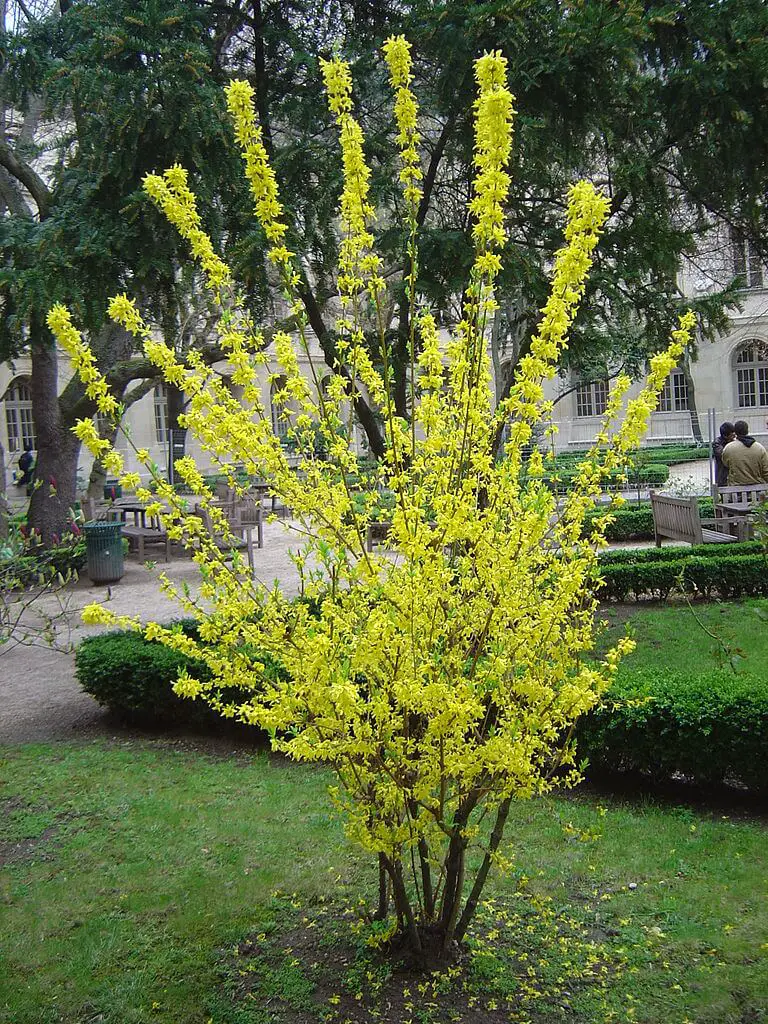
Photo by David Monniaux (Wikimedia Commons) (CC BY-SA 3.0)
The most important members of the Forsythia variety are Forsythia suspensa and Forsythia Viridissima. Both are variable species and also garden hybrids. Among them, the western world first discovered Forsythia suspensa variety. Later, Forsythia Viridissima was introduced into Europe.
Carl Peter Thunberg, a Swedish naturalist, grew Forsythia suspensa in his Japanese garden in 1784. He also mentioned it in his famous book “Flora Japonica” as a lilac.
He had professional connections with the Dutch East India Company. Through this connection, Forsythia suspensa reached Holland in 1833. Veitch Nurseries sold this plant in England.
During this period, Forsythia viridissma found its way into European markets. Eventually, it gained more popularity than Forsythia suspensa. As a result, Europeans began using Forsythia viridissma most widely than Forsythia suspensa.
Robert Fortune, a Scottish plant-hunter found this species at mandarin’s garden in Chusan, China. Later, he discovered the plant’s wild growth in the Zhejiang mountain ranges. For studying further, he transported this variety to Europe.
In 1880, European botanists introduced Forsythia × intermedia in the European market. In fact, it is a hybrid of Forsythia viridissma and Forsythia suspensa. This variety also exhibits variable characteristics. Royal Horticultural Society announced its famous “Award of Garden Merit” to Forsythia × intermedia.
Forsythia Hedge Species
The documented Forsythia species are as follows:
Forsythia europaea Degen & Bald. Balkans in Albania and Serbia
Forsythia togashii H.Hara. Japan (Shōdoshima).
Forsythia japonica Makino. Japan.
Forsythia suspensa (Thunberg) Vahl. Eastern and central China
Forsythia viridissima Lindley. Eastern China
Forsythia × intermedia. Garden hybrid between F. suspensa and F. viridissima.
Forsythia giraldiana Lingelsh. Northwest China.
Forsythia × mandschurica Uyeki. Northeast China.
Forsythia mira M.C.Chang. Northcentral China
Forsythia likiangensis Ching & Feng ex P.Y.Bai. Southwest China
Forsythia ovata Nakai. Korea.
Forsythia saxatilis (Nakai) Nakai. Korea.
Forsythia koreana (Nakai) T.B.Lee. Korea
Forsythia velutina Nakai. Korea.
Among them, Forsythia viridissima and Forsythia suspensa are the most important species. Also, Forsythia × intermedia, a hybrid of them, is most popular in the gardening world.
Description of Forsythia Hedge

Photo by Famartin (Wikimedia Commons) (CC BY-SA 4.0)
Forsythia hedges are deciduous shrubs. They normally grow 1–3 m (3 ft 3 in–9 ft 10 in) tall. On some rare occasions, they can grow 6 m (20 ft) tall also. The barks are usually grey-brown in color. The simple leaves are borne opposite one another. Sometimes they can be trifoliate also. usually, the leaves measure about 2-10 cm in length with serrated margins.
Typically, the trees produce flowers in early spring before the sprouting of leaves. The deep four-lobed flowers are bright yellow in color. The smooth petals of the flower sprout out from the central base. These petals hang down during rains to protect the reproductive parts. The fruits contain numerous winged seeds in the form of a dry capsule.
Some botanists argue the flowers of this tree produce milk sugar (lactose). However, established documents did not confirm the same.
Choosing the Right Variety
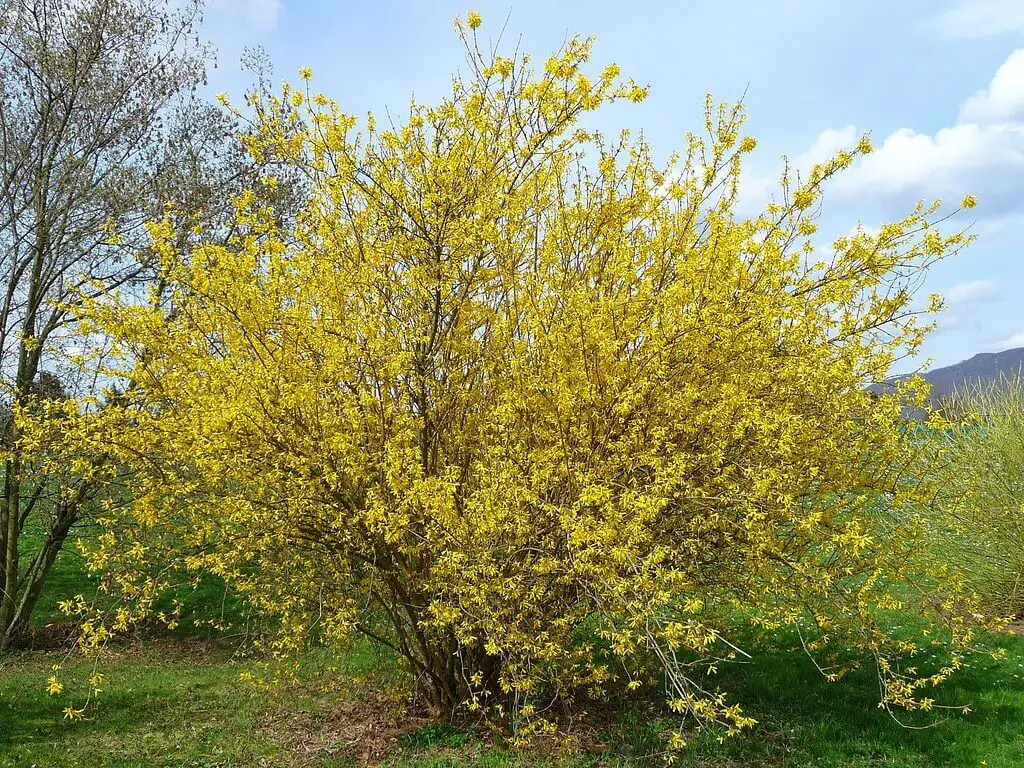
Photo by 4028mdk09 (Wikimedia Commons) (CC BY-SA 3.0)
There are a number of varieties available for you to choose from. So, first, make sure your purpose for growing this tree. For example,
Forsythia suspensa has weeping branches. You can allow this plant to creep or treat it as a vine. You can also grow them as ground covers forming roots. Interestingly, very few species on earth have these variable characteristics.
Forsythia viridissima, aka greenstem is a compact tree. It grows upright like normal plants. You can grow it as a fence with wonderful yellow flowers.
Forsythia x intermedia is a hybrid of the above. So, it has both upright branches and arching capabilities. You can use it flexibly while decorating your hedges. This variety is a popular prolific bloomer. However, it has comparatively less dense branches. Hence, it may not be an ideal choice for privacy screening.
There are some dwarf varieties of Forsythia. You can use them to divide properties in a beautiful way. It is called a ‘fence without fencing’. These varieties usually grow upright and compact.
You can also interplant these plants with other shrubs. This provides a distinctive look to your spaces. But, choose shrubs that have similar characteristics.
Propagating Forsythia Hedge
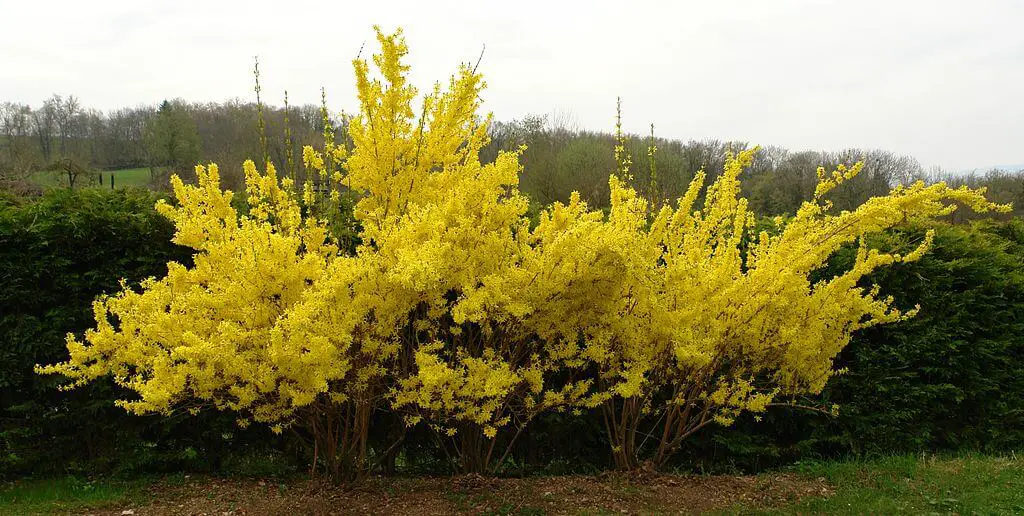
Photo by Yann (Wikimedia Commons) (CC BY-SA 4.0)
You can buy this plant online. You can also propagate it by stem cutting or layering. It barely needs water and is easy to maintain.
USDA recommends Hardiness Zones 5 to 8 to grow this plant. Select the location where you want to hedge. Measure the end-to-end distance of the location. Plant the trees with a measured distance.
For example, small shrubs require 1-2 feet distance between them and medium shrubs require 4-6 feet distance between them. Similarly, large shrubs require 8-10 feet distance between them. In addition, you must calculate and add the space required by a matured plant.
Dig a long trench as per the above measurement. For example, if you plant large shrubs, the length of the trench should be 8-10 feet plus space as required by the matured shrub.
Plant the shrubs in a zig-zag pattern along the trench. usually, this encourages the plants to intertwine well and increases the thickness of the fencing. Hence, you can enjoy better privacy.
You can also plant in a straight line. But you may not get dense fencing. However, you can enjoy the cultured’ looks.
If you prefer mixed color fences, interplant different types of cultivars. However, choose the ones that have similar growth habits and characteristics. This prevents the shrubs from casting shadows on one another and also the fight for resources.
However, if you prefer uniform looks, grow a single cultivar type. Being simple, this method provides unformed cultured’ looks to your fences.
After propagation, you can witness new growth within a few days. New canes shoot up a couple of feet quickly. Typically, these plants establish themselves with a few weeks’ time. Most architects prefer these plants for their quick-growing habits.
Prune from the Initial Growth
After planting, prune the plants regularly. This ensures uniform growth and provides beautiful looks to your spaces. In this way, you can maintain the plants well-trimmed and train them to grow in a particular shape
To form beautiful formal hedges, train your plants by pruning them from the initial stages of growth itself.
Whenever the plant reaches a foot in height, prune it off by six inches. Make sure to prune a few mm above the leaf set. Repeat this procedure until the growing cycle completes. This promotes even branching from the bottom to the top.
On the flip side, the plants may seldom bloom or never bloom until the completion of the growing cycle. However, the plants establish themselves at a height you desire, one foot in our case.
Alternatively, you can leave the canes to grow naturally. Then prune the top edges off at a height you wish. In this method, the plant grows narrower at the base and wider at the top.
Hence, the bottom portion receives fewer or no sunlight. As a result, the plants develop less foliage and fewer blooms. Naturally, the density of blooming is proportional to the amount of sunlight received.
In addition, the plants become vulnerable to common plant diseases due to deprived sunlight. Some plants even die because of these causes. Hence, this method is not recommended.
How to Prune
You can grow your hedges in rounded, boxy, or other shapes. Using sterilized, sharp shears, prune the hedges in accordance with the desired shape. As a general rule, the bottom portion of the plant should be wider than the top. This ensures equal sunlight throughout the plant. So, angle your shears accordingly.
While pruning, make sure to give random deep cuts at different portions of the hedges. This widens the air path and increases sunlight exposure. Periodical Pruning helps to maintain the shapes of hedges and also encourages new fresh growth.
Forsythia Hedge plants tend to develop low branches. Upon contacting the soil surface, these low branches root readily. While pruning, pay special attention to cut off these branches as they can ruin the shape of the hedges.
Make sure to remove the dead heads and spent blooms as they provide unpleasant looks. After completing the pruning, rake and dispose of the debris immediately. Accumulating debris is an invitation to common pests and diseases.
Pruning Frequency
Generally, gardeners prune the plants after the blooming season. The Forsythia Hedge plants immediately set buds for the next season as the flowers drop. To worsen the case, the leaves develop covering the buds even before the old flowers drop off completely. Hence, pruning the plants without damaging the buds is a challenging task.
Some gardeners prune the plants twice a year – after the blooming season, then in summer. Hence, more buds are damaged. As a result, the plants bloom less during the next season.
So, it is recommended to prune the plants only after the blooming season. Avoid the same in summer. While doing so, take care not to damage the fresh buds.
Alternatively, you can simply prune off the plants a little bit shorter than the height you wish. You can also prune off the plants to about one-third of their growth. The plants will compensate for the loss by growing vigorously and sprouting new buds for the next season.
With age, the inner branches tend to lose strength and die. This ruins the health of the whole plant. Therefore, all Forsythia Hedge varieties require deep pruning at least once every three years. Make sure to remove the dead branches and dispose them of.
Uses
Ornamental Uses
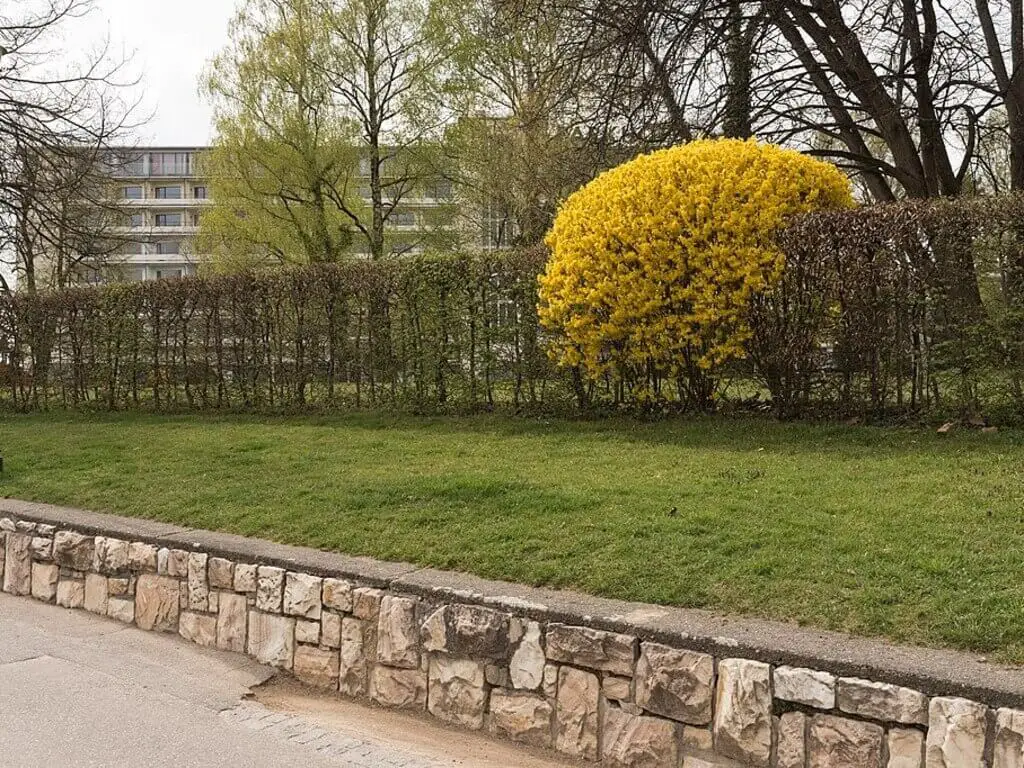
Photo by Johann Jaritz (Wikimedia Commons) (CC BY-SA 4.0)
You can plant them as a single cultivar or mix them with other shrubs (of similar characteristics) to beautify the garden spaces.
Forsythia Hedge plants can serve as effective hedging plants in your spaces. You can also use them as marker plants to mark your property perimeter. Some architects seclude private garden rooms by growing these plants accordingly.
You can also use these plants to block unpleasant views. Some people grow these plants to form thick boundaries in order to shield their outer space from disturbing onlookers.
Medical Uses
The Chinese traditional herbal therapy called Chinese herbology uses Forsythia suspensa as one of its most important 50 fundamental herbs.
Although there is Insufficient Evidence for the cure, some traditional forms of medicine use Forsythia verities to treat the following diseases:
Fever.
Pain and swelling (inflammation).
Sore throat (pharyngitis).
Heart disease.
HIV/AIDS.
Gonorrhea.
Nausea and vomiting.
To increase menstrual flow.
Infection of the skin (erysipelas)
Swelling (inflammation) of small airways in the lung (bronchiolitis).
Swelling (inflammation) of the tonsils (tonsillitis).
Other Uses
Some varieties of these plants have smooth, soft shoots. Koreans use these sticks to play ajaeng, their iconic string instrument.
Similar Plants
All about Dietes Bicolor Plants
How to Grow Calico Aster in the Garden

